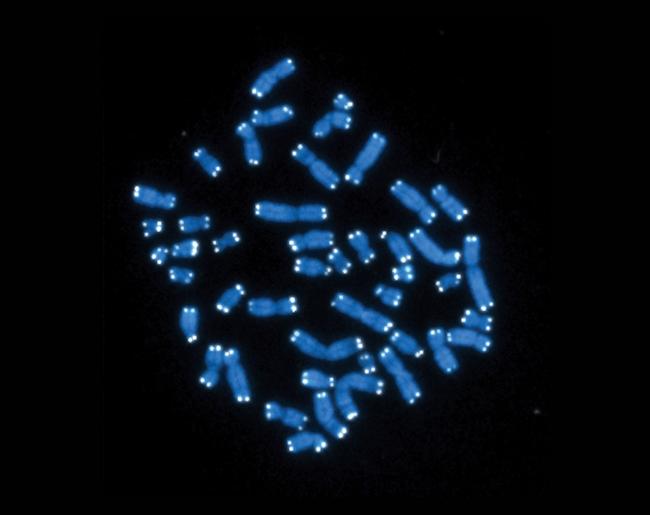Enzyme active in cancer also protects normal cells
September 17, 2019
Enzyme active in cancer also protects normal cells
At a Glance
- Researchers found that the enzyme telomerase, which is active in most tumor cells, may also protect healthy adult cells from becoming cancerous.
- The findings give new insights into cellular aging and the development of cancer.

Telomeres are stretches of repeated DNA that caps the tips of chromosomes. They protect chromosome ends from unraveling. Telomeres gradually shorten over rounds of cell division. At a certain point, when a cell’s telomeres reach a critical length, cells cease to divide. They may die or simply no longer do their jobs. Cells in this state, called senescence, are more prone to become cancerous.
The enzyme telomerase can counteract cellular aging by lengthening telomeres. It’s produced in certain types of cells—such as embryonic cells, adult stem cells, and immune cells—that give rise to other more specialized cells. Telomerase is also abnormally active in most tumors. The enzyme allows tumor cells to maintain long telomeres and divide uncontrollably. Telomerase activity was thought to be turned off in most of the body’s other cells.
A team led by Dr. Kan Cao from the University of Maryland, NIH Director Dr. Francis Collins, and Dr. Richard Hodes, who is director of NIH’s National Institute on Aging (NIA), wanted to know whether telomerase might play a role in the aging of healthy adult cells as well. They studied cells from mice and humans. Their work was supported by NIH’s National Heart, Lung, and Blood Institute (NHLBI), National Cancer Institute (NCI), and National Human Genome Research Institute (NHGRI). Results appeared on September 2, 2019, in the Proceedings of the National Academy of Sciences.
The team first investigated mice with critically short telomeres. These mice were the offspring of a long line of genetically modified mice that lacked one copy of a gene needed to produce telomerase. By breeding the mice, researchers produced offspring that were unable to make telomerase and those with a fully functional version of the gene. Over 26 generations of breeding, the mice’s telomeres got steadily shorter until they reached a critical length. These mice have shorter lifespans and had more instances of tissue wasting than their siblings with normal telomerase production.
Comparing skin cells from the siblings, the researchers found that cells from the mice unable to make telomerase stopped dividing sooner and were more likely to become cancerous. In cells from normal siblings, the scientists detected an increase in telomerase activity before the cells had reached a certain stage in their life cycles. This uptick in activity slowed telomere shortening to prevent the cells from becoming senescent, where they were more likely to turn cancerous.
The team studied human skin cells as well. In both the human and mouse cells, turning down the telomerase gene’s activity through gene editing sped senescence and made cells more likely to turn cancerous. When telomerase production was restored by reactivating the gene, cells were able to divide for a longer period and avoid senescence. These results show that telomerase can play a protective role in normal cells to prevent senescence and tumor formation.
“This study reshapes the current understanding of telomerase’s function in normal cells,” Cao says. “Our work shows, for the first time, that there is a role for telomerase in adult cells beyond promoting tumor formation. We can now say that regulated activation of telomerase at a critical point in a cell’s life cycle serves an important function.”
“While there is still much to learn,” Hodes says, “our collective efforts to date are enhancing our understanding of what regulates cell replication, survival, and susceptibility to cancer, and may ultimately result in better treatments and cures for a wide range of diseases.”
—by Erin Bryant
Related Links
- Senescent Cells Linked to Brain Disease in Mice
- Eliminating Senescent Cells Extends Healthy Life in Mice
- Drugs Extend Healthy Lifespan in Mice
- Aspects of Aging Might Be Reversed
- Gene Rejuvenates Mouse Embryonic Stem Cell Immortality
- Genes that Protect Chromosome Tips May Boost Longevity
- New Telomerase Protein Discovered
- Decoding Telomere Biology and Cancer Risk
References
Transient induction of telomerase expression mediates senescence and reduces tumorigenesis in primary fibroblasts. Sun L, Chiang JY, Choi JY, Xiong ZM, Mao X, Collins FS, Hodes RJ, Cao K. PNAS. 2019 Sep 3 pii: 201907199. doi: 10.1073/pnas.1907199116. [Epub ahead of print]. PMID: 31481614.
Funding
NIH’s National Heart, Lung, and Blood Institute (NHLBI), National Cancer Institute (NCI), and National Human Genome Research Institute (NHGRI).


